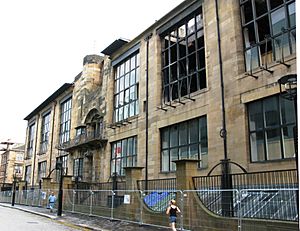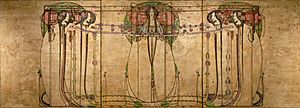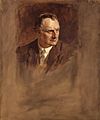Glasgow School facts for kids
The Glasgow School was a group of important artists and designers. They came together in Glasgow, Scotland, starting in the 1870s. Their work was most popular from the 1890s to about 1910.
This group included famous smaller teams like The Four (also called the Spook School), the Glasgow Girls, and the Glasgow Boys. They were part of a bigger art movement called Art Nouveau from around the world. They created a special look known as the Glasgow Style.
Glasgow was growing fast and doing well financially in the late 1800s. This helped artists create unique works, especially in architecture, interior design, and painting, as part of the Art Nouveau movement.
Contents
The Four: Spook School Artists
A very important group within the Glasgow School was called The Four. They helped define the unique Glasgow Style.
The members of The Four were:
- Margaret MacDonald, a talented painter and glass artist.
- Charles Rennie Mackintosh, a famous architect and Margaret's husband.
- Frances MacDonald, Margaret's sister.
- Herbert MacNair.
Together, The Four mixed different art styles into the Glasgow Style. These styles included the Celtic Revival (inspired by ancient Celtic art), the Arts and Crafts Movement (focused on handmade quality), and Japonisme (influenced by Japanese art). Their unique style became popular across Europe in the modern art world.
The Four were also known as the Spook School. This name was first used by others to make fun of their art. People thought their art "distorted" or changed human shapes in a strange way. But their work had a big impact on the Art Nouveau movement.
The Glasgow Girls: Female Artists
The Glasgow Girls is a name given to a group of talented female artists and designers. Many of them studied at the Glasgow School of Art.
Some of the well-known Glasgow Girls include:
- Margaret Macdonald Mackintosh and Frances MacDonald (both also part of The Four).
- Jessie M. King
- Annie French
- Helen Paxton Brown
- Jessie Wylie Newbery
- Ann Macbeth
- Bessie MacNicol
- Norah Neilson Gray
- Stansmore Dean
- Dorothy Carleton Smyth
- Eleanor Allen Moore
- De Courcy Lewthwaite Dewar
- Agnes Banks Harvey (a silversmith).
Women artists were able to do very well in Glasgow between 1885 and 1920. This was a time when women were actively pursuing art careers. The Glasgow School of Art became famous worldwide during this period.
Many people believe this success was due to the "progressive" head of the art school, Fra Newbery. He created a good environment where women could succeed as both students and teachers. Women also benefited from the new Glasgow Society of Lady Artists, started in 1882. This society gave women artists a place to meet and show their work.
Many students and staff at the art school also supported women's suffrage, which was the movement for women to gain the right to vote. Students even helped by "stitching up banners" for the movement between classes.
How the Name "Glasgow Girls" Started
The name "Glasgow Girls" was not used at the time these artists were working. It appeared much later, in the 1960s. People wanted to give more attention to the work of these women artists. This was to balance the many discussions about the Glasgow Boys.
It is thought that William Buchanan, who led the Scottish Arts Council, first used the name. He used it in a catalog for a 1968 exhibition about the Glasgow Boys. This new name was a way to refer to the women's group, similar to the men's group.
The term "Glasgow Girls" became even more popular because of a big exhibition. This show, called Glasgow Girls: Women in Art and Design 1880-1920, was organized by Jude Burkhauser in 1990.
-
Opera of the Winds by Margaret Macdonald Mackintosh, 1903
-
The Goose Girl by Bessie MacNicol, 1898
The Glasgow Boys: Realism in Art
Around the 1880s and 1890s, another group of artists became known as the Glasgow Boys. They were exploring and expanding on the styles of Impressionism and Post-impressionism.
Their paintings often showed everyday scenes from the countryside around Glasgow. They used bright colors to capture the many different parts of Scotland's character.
Most of the Glasgow Boys were trained in Glasgow or had strong connections to the city. They shared a passion for realism and naturalism. This means they wanted to show things as they truly looked in real life. They also disliked the traditional art establishment in Edinburgh, which they felt was too strict.
Driven by these ideas, they created amazing artworks and became important Scottish artists.
Waves of Artists
The Glasgow Boys included several artists who joined the group at different times:
- First Wave: Leading figures were James Paterson and William York Macgregor. They often met at Macgregor's studio.
- Second Wave: This group included Joseph Crawhall, Thomas Millie Dow, James Guthrie, George Henry, E. A. Hornel, James Whitelaw Hamilton, and E. A. Walton.
- Third Wave: Artists like David Gauld, William Kennedy, John Lavery, Harrington Mann, Stuart Park, William Wells, David Young Cameron, Alexander Ignatius Roche, Arthur Melville, Thomas Corsan Morton, James Nairn, George Pirie, and John Quinton Pringle were part of this wave.
Artistic Influences and Style
The Glasgow Boys were influenced by Japanese prints, French Realism (especially artist Jules Bastien-Lepage), and James Abbott McNeill Whistler. Their travels around the world, especially to Spain, North Africa, and Japan, also greatly inspired their art.
They were always influenced by what they saw around them. They worked hard to show these images using realism and naturalism. They wanted to paint things exactly as they are. This is why they often chose to work outdoors.
Working outdoors allowed them to create paintings that looked as real as possible. They could paint real people in their natural surroundings. This idea of creating naturalistic paintings was new for their time, making their techniques very innovative.
Their paintings often showed a sense of movement, accurate light and shadow, and very realistic textures. These qualities made them stand out in the art world.
-
Edward Grey, 1st Viscount Grey of Fallodon by Sir James Guthrie, c. 1924 – c. 1930
Collections and Exhibitions
You can find a large collection of art by the Glasgow Boys at the Kelvingrove Art Gallery and Museum. One room there is dedicated to their work. The museum has over 60 of their pieces, created between 1880 and 1900. Many believe these years were when they produced their best and most innovative art.
More of their works are on display at other places, including:
- The Burrell Collection
- Broughton House
- Paisley Museum and Art Galleries
- Walker Art Gallery
- The Hunterian Museum and Art Gallery
See also
- Glasgow School of Art
- Scottish Colourists
- Ann Macbeth
- Arthur Melville
- George Henry Walton
- Hannah Frank
- Margaret Macdonald Mackintosh
- Frances MacDonald











